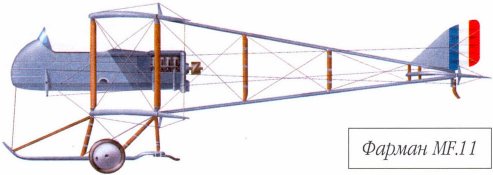В.Кондратьев Самолеты первой мировой войны
МОРИС ФАРМАН MF.11 / MAURICE FARMAN MF.11
Многостоечный двухместный биплан смешанной конструкции с толкающим винтом. Разработан братом Анри Фармана Морисом в 1914 году. Некоторое время авиаконструкторы братья Фарман, совладельцы одной фирмы, придерживались разных взглядов на то, каким должен быть военный аэроплан. Это отразилось в различии создаваемых ими аппаратов. В частности, Морис предпочитал не ротативные, а стационарные двигатели, иной способ размещения гондолы ("подвешивая" ее на стойках между крыльями), двойные рули поворота и т.д. Благодаря более высокой мощности моторов самолеты Мориса Фармана превосходили по летным характеристикам машины его брата. M.F.11 выпускался серийно на фирме Фарман, а также в Италии, где на него ставили мотор "Фиат" A10. Аэроплан начал поступать на западный фронт в мае 1915-го, постепенно заменяя "Фарманы" F.20, F.21 и F.22. На западе MF.11 получил более широкое распространение в боевых частях, чем аппараты Анри Фармана, однако, В России он почти не встречался. На "Морис Фарманах" воевали в 1915-1916 годах 37 французских и 24 итальянских эскадрильи. При этом некоторые машины оснащались импровизированным бронированием передней части гондолы. Отдельные экземпляры использовали англичане в Македонии и в Дарданелльской операции. В начале 1916-го, по мере поступления в передовые части более совершенных аппаратов, французские MF.11 начали переводить в учебные подразделения. На Итальянском фронте они применялись гораздо дольше.
ДВИГАТЕЛЬ
"Рено", двухрядный, V-образный, воздушного охлаждения, мощностью 80, 100 или 130 л.с., или аналогичный "Де Дион" в 100 или 130 л.с.
ВООРУЖЕНИЕ
На некоторых машинах ставили шкворневый пулемет.
А.Шепс Самолеты Первой мировой войны. Страны Антанты
Фарман MF.11 1912 г.
Развитие машин серий MF.7 и MF.9. Носовая рулевая поверхность снята. Гондола поднята на стойках под нижним крылом и имела более компактную конструкцию. Фермы стандартной "фармановской" конструкции, параллельные, сходящиеся на стабилизаторе. Рули поворота имели два небольших киля. Шасси стандартные для всех машин типа "Фарман". Двигатель 7-цилиндровый, воздушного охлаждения, ротативный "Гном" (60 или 70 л. с.), позднее - рядный "Рено" (80 л. с.). Большого распространения машина не получила, как и MF.9, хотя MF.11 с двигателем "Рено" использовался как учебный.
ЛЕТНО-ТЕХНИЧЕСКИЕ ХАРАКТЕРИСТИКИ
MF.11, 1913г. MF.11, 1914г.
Размах, м 16,10 15,9
Длина, м 9,74 9,3
Площадь крыла,кв.м. 52,10 60,6
Сухой вес, кг 550 650
Взлетный вес, кг 800 960
Двигатель "Рено" "Рено"
мощность, л.с. 80 130
Скорость максимальная, км/ч 90 116
Время набора высоты, м/мин 2000/21
Потолок, м 4100
Экипаж, чел. 2 2
Вооружение нет
В.Шавров История конструкций самолетов в СССР до 1938 г.
"Морис Фарман" учебный (М. Ф.-11) применялся в небольшом количестве как учебный в 1915-1917 гг. По схеме и конструкции близок к "М. Фарман-40", но шасси были с полозами. Двигатель - "Рено" в 70 л. с., потом в 80 и 90 л. с., все двухрядные 8-цилиндровые, воздушного охлаждения.
"Морис Фарман" поплавковый (гидроаэроплан Фармана) был двух типов: 1912 г. - с передним рулем высоты и 1914 г. - поплавковый вариант учебного самолета "Морис Фарман" с двигателем "Рено" в 70 л. с., потом 80 л. с. в обоих типах. Первый тип был в двух экземплярах на Балтике. Второй был куплен в 1914 г. в 20 экземплярах, которые и применялись в морской авиации на Балтике до 1917 г. Один самолет был взят в гидрографическую экспедицию Вилькицкого. На нем же 7-12 августа 1914 г. поручик Ян Иосифович Нагурский летал над Новой Землей в поисках экспедиции Г. Я. Седова. Это были первые полеты в Арктике.
Самолет|| учебный/ поплавковый
Год выпуска||1914/1913
Двигатель, марка||/
Мощность||80/70
Длина самолета, м||9,74/8,3
Размах крыла, м||16,1/13,2
Площадь крыла, м2||52,10/50
Масса пустого, кг||550/580
Масса топлива+ масла, кг||110/80
Масса полной нагрузки, кг||250/240
Полетная масса, кг||800/820
Удельная нагрузка на крыло, кг/м2||15,3/16,4
Удельная нагрузка на мощность, кг/лс||10,0/11,7
Весовая отдача, %||31/29
Скорость максимальная у земли, км/ч||90/90
Скорость посадочная, км/ч||55/60
Продолжительность полета, ч.||?/4
L.Opdyke French Aeroplanes Before the Great War (Schiffer)
Deleted by request of (c)Schiffer Publishing
MF 11: Like the Type 7, the 2-seater 11 in its produced form, the 11bis, was the ancestor of hundreds of machines used by the Armee de l'Air in WWI. It was similar to the MF 10.
(Span: 16.13 m; length: 9.48 m; wing area: 52 sqm; empty weight: 620 kg; loaded weight: 945 kg; speed: 118 kmh; Renault)
Possibly derived from the MF 11 was a hydro numbered 17, piloted by Renaux at Monaco. It used 2 big floats and 2 bubble floats aft.
M.Goodall, A.Tagg British Aircraft before the Great War (Schiffer)
Deleted by request of (c)Schiffer Publishing
AIRCO: MAURICE FARMAN S.11 Shorthorn
The MF S.11 Shorthorn was derived from the Longhorn by the removal of the front elevator and its structure. The biplane tail was discarded in favor of one of monoplane type, with twin fins and rudders of triangular shape, supported by booms tapering in side elevation.
The Shorthorn appeared late in 1913 and was introduced into the RFC in the following March. It is not certain when Airco produced their first aircraft, as some were also purchased from the Farman Company. The type was used in early operations but continued in use to the end of the war, mainly in the training role.
Production of the type continued at Airco into 1918, with the Whitehead Company also a contractor.
Power: 80hp Renault eight-cylinder air-cooled vee.
Data
Span top 51ft 9in (15.78m)
Span bottom 38ft 8in. (11.76m)
Area 561sq ft (52sq m)
Length 30ft 6in (9.3m)
Weight 1,441 lb (654kg)
Weight allup 2,046 lb (928kg)
Speed 72mph(116kph)
Endurance 3 3/4hr
Climb 15min to 3,280ft (1,000m)
O.Thetford British Naval Aircraft since 1912 (Putnam)
Maurice Farman Shorthorn
Both the Maurice Farman Shorthorn and the Longhorn were being supplied to the RNAS by the Aircraft Manufacturing Company at Hendon before the First World War. Among the first 200 official serial numbers allotted by the Admiralty for naval aircraft, the S.7 Longhorn made its first appearance as No.23, and the S.11 Shorthorn as No.29. The latter was a twin-float seaplane (as shown in the three-view drawing), and was stationed at Great Yarmouth from July 1913. Another of the early Shorthorn seaplanes appeared on strength at Cromarty in July 1913.
The Longhorn and the Shorthorn (the latter distinguished by the absence of a forward elevator) had been introduced to the British flying services as trainers at the Central Flying School as early as 1912, and they continued to serve in this role with both the RFC and the RNAS.
Whereas the Longhorn was used only as a trainer, the Shorthorn also saw operational service for reconnaissance and bombing. Of the RNAS's first-line strength of 40 landplanes and 31 seaplanes on 4 August 1914, four were Maurice Farman landplanes fitted with 70 hp or 100 hp Renault engines.
The Maurice Farmans, with 100 hp Renaults, accompanied Samson's No.3 Squadron, RNAS, to the Dardanelles and were flown over the Turkish lines.
The last Shorthorns delivered to the RNAS were 20 built as trainers by the Eastbourne Aviation Company. The RNAS used 90 Shorthorns in all.
UNITS ALLOCATED
With Wg Cdr Samson's unit in Belgium, later No.3 Squadron RNAS, at Dardanelles. RNAS stations at Calshot, Cromarty, Grain and Great Yarmouth.
TECHNICAL DATA (S.11 SHORTHORN)
Description: Two-seat reconnaissance and bombing aircraft, also used for training. Wooden structure, fabric covered.
Manufacturers: Henry and Maurice Farman, Billancourt (Seine), France. Sub-contracted by Aircraft Manufacturing Co Ltd, Hendon, Eastbourne Aviation and others.
Power Plant: One 70 hp or 100 hp Renault.
Dimensions: Span, 53 ft. Length, 30 ft 8 in. Height, 10 ft 4 in. Wing area, 561 sq ft.
Weights: Empty, 1,441 lb. Loaded, 2,046 lb.
Performance: Maximum speed, 66 mph at sea level. Climb, 15 min to 3,000 ft. Endurance, 3 3/4 hr.
Armament: No defensive armament normally carried. Light bomb-load below wings.
R.Mikesh, A.Shorzoe Japanese Aircraft, 1910-1941 (Putnam)
Army Henri Farman Type Model 4 Aeroplane (Army Type Mo-4 Aeroplane)
The introduction of this aeroplane into Japanese military service, was the zenith of the Farman pusher biplanes in Japan. Earlier Farman types were already established, but one Henri Farman 1914 aeroplane which the Association imported from France in November 1914 would develop as a noteworthy type. The PMBRA decided to develop the aircraft further by making a new aeroplane using many of the changes perfected on the earlier converted Type Mo and Kaishiki No.7. Although Lt Shigeru Sawada was killed in the earlier Kaishiki No.7 Small Aeroplane, many development projects were being undertaken simultaneously, and Lt Sawada was in charge of this new design which used many of his earlier innovations. Noticeable differences with his redesign included the raising of the fuselage nacelle above the lower wing and providing a small triangular rudder and shorter undercarriage skids. It was completed in November 1915 three months after beginning the design. It was later discovered that similar conversions were being made in France without the knowledge of either user.
The Association called the new design the Sawada Type B 7, but it was officially designated Kaishiki 4th Year Model. These Association-built aircraft had a Japanese-made 70hp Renault engine installed which gave more power than the French-built aeroplane.
Participating in the military review held by the Emperor on 2 December, 1915, Lt Morikichi Sakamoto of the Association flew one of these new aeroplanes over the Komazawa Parade Grounds in winds gusting up to 45mph. Stability and performance were easily apparent when comparing the difficulties being experienced by the older Type Mo 1913s, and as a result the Type Mo 4th Year Model was regarded as revolutionary. Meeting with strong approval, the type was put into production at the Association's factory at Tokorozawa, as well as the Tokyo Army Artillery Arsenal and the Atsuta Army Weapon Manufacturing Works of Nagoya Army Ordnance Arsenal.
The aeroplane had a number of designation changes, beginning as the Type Mo 1914, followed by the Type Mo 4th Year Model, and after 1918 becoming the Type Mo4. They were used first as trainers at Tokorozawa for navigation, scouting and bombing, later to replace the Type Mo 1913s of the balloon company (squadron equivalent) and flight company that had been formed at Tokorozawa in December 1915 as part of an air battalion. When the Japanese Army deployed its 12th Division to Siberia in 1918, several air units were organized, one of which was sent to northern Manchuria, then to Siberia for patrol duties using eight Type Mo-4s, six Mo-6s and nine Sopwith 1A2 reconnaissance aircraft imported from England.
In time, a number of the Type Mo-4 aircraft passed into civil hands and were used as trainers with the Imperial Flying Association and Kishi Aeroplane Manufacturing Works (later Akabane Aeroplane Manufacturing Works). The former modified a Type Mo-4 with an additional fuel tank in the second crew position making it a single-seat aircraft. Called the No.2 Mie-go, it made a nonstop record flight between Tokyo and Osaka. Piloted by Masao Goto, it left
Tokorozawa and landed at the Osaka Joto Parade Grounds, in 6hr 28min, on 1 April, 1918, a remarkable record for duration and distance in Japan for that period. The Type Mo-4s remained popular from when they were first manufactured in the autumn of 1915, and were put into production again in 1919 and 1920.
Single-engine pusher sesquiplane reconnaissance aircraft with crew nacelle. Wooden strucrure with fabric covering. Tail elevator only. Skid-type undercarriage with dual wheels. Crew of two in open cockpit.
70-80hp Renault eight-cylinder vee air-cooled engine, driving a Chauviere two-bladed wooden propeller.
One machine-gun when necessary.
Span 15.50m (50ft 10 1/4in); length 9.14m (29ft 11 3/4in); height 3.18m (10ft 51 1/4in); wing area 58sq m(624.327sq ft).
Empty weight 563kg (1,241lb); loaded weight 778kg (1,715lb); wing loading 13.4kg/sq m (2.7Ib/sq ft); power loading 9.73kg/hp (21.4lb/hp).
Maximum speed 49kt (56mph); climb to 2,000m (6,562ft) in 25min; service ceiling 3,000m (9,843ft); endurance 4hr.
Eighty-four built: nine PMBRA, Fifty-one Army Arsenals (Tokyo and Nagoya), twenty Tokorozawa Branch, Supply Dept, three Imperial Flying Association (civil use), one Kishi Aeroplane (civil use).
Army Maurice Farman Type Model 6 Aeroplane (Army Type Mo-6 Aeroplane)
Another stage of development came from advanced aero engines of 100hp or more, products of the First World War. To take advantage of these, Japan imported several liquid-cooled engines including the 90hp Curtiss OX-5 and the 100hp Daimler, each of which was tested by installing them in a Type Mo-4 Aeroplane. Impressed by the Daimler engine, the Army Artillery Arsenal began its manufacture in 1916, completing the first in the spring of 1917.
This Daimler-type engine was installed in an aeroplane that was newly designed for it. Since the aeroplane powered by this engine had had its start in May 1916, the PMBRA designated it the Type Mo6-Year Model, but later the Army's official designation became the Type Mo 6th Year Model for the year of Taisho. In 1918 it was redesignated as the Type Mo Model 6, or the Type Mo-6 in short.
Outwardly, the Type Mo-6 was almost identical to the Type Mo-4, but was slightly larger and heavier and had coolant radiators on each side of the engine. Production models had shorter front skids and the front supporting diagonal strut to the skid was eliminated. On the production model there was an increase in fuel-tank capacity which made the loaded weight higher than that of the Mo-4, but the Mo-6 had a marked increase in speed from 49kt to 60kt. Production began in the autumn of 1917 at which time Mo-4 production was terminated. The Mo-6 became the Army's first Japanese-designed reconnaissance/trainer to be produced in quantity.
The new Army aeroplane made a good start when the first of the series, No.101, set a two-seat altitude record of 2,800m (9,186ft) on 25 May, 1917, while being flown by Lt Morikichi Sakamoto and Army Engineer Shuhei Iwamoto.
All did not continue well, however, for this new aeroplane. During the November 1917 Army Special Manoeuvres on the Ohmi Plain near Lake Biwa, of the fourteen newly built Type Mo-6 aircraft participating, twelve crashed or made emergency landings because of engine malfunctions among other things. As a result, the Army Department of Aviation organized an investigating committee of twenty-five officers and specialist engineers with twenty-four pilot officers. Many problems became evident, among them the need to improve engine research and development, use of better materials, improve training for engineers, and better communications between PMBRA and the operational flying units. Many of the problems were corrected, thus extending the aircraft's operational life long past their practicality as combat aircraft.
However during their service life, these Type Mo-6 Aeroplanes became the Army's last biplane pusher aircraft. When the 2nd Army Air Battalion was being organized, in December 1917, Type Mo-6s from Tokorozawa became its initial equipment. This unit was formed at the Army's newly activated airfield at Kagamigahara in Gifu Prefecture, better known after the Pacific War as Gifu Air Base, north of Nagoya. Air battalions at Tokorozawa and Kagamigahara used their Type Mo-6s for reconnaissance and training until around 1923. When the Army sent units to Siberia and northern Manchuria in August 1918, four of the twelve aeroplanes of the 2nd Army Air Battalion were Type Mo-6s. However, because of the severe cold of the ensuing winter, they could not be used because the engine coolant froze.
One of the Type Mo-6 Aeroplanes, No.266, survived for many years by having been dismantled and stored in the rafters of what had been the Nukiyama Laboratory, of the Department of Engineering, Tohoku University, where it escaped destruction during the Second World War. It was later restored and is now preserved in the Yasukuni Shrine in Tokyo.
Single-engine pusher reconnaissance biplane with crew nacelle. All-wooden construction with fabric covering. Crew of two in open cockpit.
100-110hp Daimler six-cylinder inline water-cooled engine, driving a two-bladed wooden propeller.
One nose mounted Hotchkiss flexible 7.7mm machine-gun.
Span 16.13m (52ft 11 in); length 9.33m (30ft 7 1/2in); height 3.10m (10ft 2in); wing area 62sq m (667.364 sq ft).
Empty weight 75 kg (1,671lb); loaded weight 1,060kg (2,336Ib); wing loading 17.1 kg sq m (3.5Ib/sq ft); power loading 9.64 kg/hp (21.2Ib/hp).
Maximum speed 60kt (69mph); cruising speed 49kt (56mph); climb to 2,000m (6,562ft) in 25min; service ceiling 3,500m (11,482ft).
134 built 1917-1921: PMBRA thirty-five; Army Arsenals forty seven; Tokorozawa Branch, Supply Dept forty-eight; Akabane Aeroplane Manufacturing Works four.
Army Maurice Farman 5 Aeroplane
This aeroplane was identical to the Army Maurice Farman 1914, Type Mo-4 Aeroplane, but was equipped with dual controls for primary pilot training. With the exception of the length being extended from 9.14m to 9.38m it hardly warranted a redesignation. This became the Army's first primary trainer to be built expressly for this purpose.
Production became the responsibility of the Army Artillery Arsenal. Six were manufactured in 1919 and the Tokorozawa Branch of the Department of Supply built an additional five in 1920. However, in that year, licence rights for manufacturing the Nieuport 81E2 primary trainer came into effect and with this the Army organized a new system of flying training and, as a result, there was no further need for the Farman trainers. A few were retained at the Tokorozawa Aviation School until about 1923.
Single-engine pusher biplane primary trainer with crew nacelle. Wooden construction with fabric covering. Crew of two in open cockpit.
70-80hp Renault eight-cylinder vee air-cooled engine, or 100hp Daimler six-cylinder inline water-cooled engine, driving a two-bladed wooden propeller.
Span 15.52m (50ft 11 in); length 9.38m (30ft 9 1/4in); height 3.17m (10ft 5in); wing area 58sg m (624.327sg ft).
Loaded weight 778kg (1,715lb); wing loading 13.4kg sg m (2.74Ib sg ft); power loading 9.73 kg hp (21.4lb/hp).
Maximum speed 49kt (56mph); climb to 2,000m (6,562ft) in 35min; endurance 4hr.
Data for Renault-powered version.
Eleven built 1919-1920: Army Artillery Arsenal six; Tokorozawa Branch, Dept of Supply five.
Kishi No.3 Tsurugi-go Aeroplane
Suspecting the unsafe design of the sweptback wing used on the No.2 Tsurugi-go, this new aeroplane used the conventional straight wing, very much like that of the Army Maurice Farman Type Mo-4. Although the centre cockpit nacelle was original in design structure, other parts of the airframe were identical to the Type Mo-4.
After its first public flying demonstration on 11 February, 1917, japan's National Foundation Day known as Kigensetsu, Kishi designated the aeroplane as the No.3 Tsurugi-go. Acting as flying instructor, Lt Inoue used it to introduce many people to the experience of flying an aeroplane. Because of its activity at the Susaki Airfield on reclaimed ground, the site became known as Kishi Airfield. Eventually, this aeroplane went to Itoh Airfield.
Kishi No.6 Tsurugi-go Aeroplane
In the autumn of 1918, the Akabane Aeroplane Manufacturing Works was awarded an initial Army contract for four Maurice Farman Type Mo-6s. At about that time, through the influence of Viscount Shimpei Goto, Dr Kishi received the support of a noted businessman, Soichiro Asano, and they reorganized and expanded the company, undertook the manufacture of automobiles, and established a flying-cadet programme for schoolage boys at the aerodrome.
Less attention was given to the production order for the new No.6 Tsurugi-go Aeroplane, and therefore the design reverted to the earlier Maurice Farman Type Mo4 so as to use existing parts. At this time, the Kishi iron ore mining business at Osore-yama in Aomori Prefecture, had failed, and Kishi became heavily in debt. The popular period of the Farman biplanes had passed and the Army cancelled further orders, forcing the Akabane Aeroplane Manufacturing Works and its flying activities to be closed in March 1921. Dr Kishi abandoned aviation and became a director of the Electricity Bureau of Tokyo, thus ending the name of Kishi in aviation.
Jane's All The World Aircraft 1913
FARMAN. Henry and Maurice Farman, 167, Rue de Silly, Billancourt (Seine) Aerodromes: Buc, pres Versailles and Etampes. Depots: Camp de Chalons--Reims. Established by H. Farman in 1908. M. Farman established works a little later. In 1912 the two brothers combined. The present works were opened in January, 1912, and had an output capacity of at least 300 machines a year in March, 1913.
M. Farman M. Farman M. Farman
Military biplane. Big military Staggered
biplane. biplane.
Length..........feet (m.) 39-1/3 (12) 46 (14) 39 (11.90)
Span............feet (m.) 50-3/4 (15.50) 65-3/4 (20) 36 (11)
Area.....,...sq. ft. (m?) 646 (60) 861 (80) 323 (30)
Weight, total, lbs.(kgs.) 1102 (500) 1433 (650) 882 (400)
Weight, useful,lbs.(kgs.) 617 (280) 882 (400) 551 (250)
Motor................h.p. 70 Renault 70 Renault 70 Renault
Speed, max....m.p.h.(km.) 56 (90) 44 (70) 69 110)
Speed, min....m.p.h.(km.) ... ... ...
Endurance............hrs. ... ... ...
Number built during 1912. ... ... ...
Remarks.--The whole of the above can easily be converted into hydro-avions --two long narrow floats without steps. H. Farmans are of wood and steel construction; M. Farman, wood. In all 1913 biplanes the ailerons are inter-connected. All 1913 machines designed to carry one or in some cases two mitrailleuse, and special attention is paid to facility for taking down for transport and re-assembling. The 1911-12 H. Farmans had elevators forward, were a good deal longer, and had more surface than 1913 models. Ailerons not inter-connected. The M. Farmans generally as now, except that all planes, etc., had rounded edges. On September 11th, 1912, Foury, in an M. Farman military, made world's endurance record to date, 13 hrs. 22 min., covering 631 miles (1,017 km.) All models of this type, also the "big military," are fitted with the Doutre stabiliser. Fabric: "Aviator" Ramie.
Latest Hydro.--In March, 1913, a new hydro was produced experimentally. There is a boat body, without steps, carrying the motor which is chain connected with the propeller. Machine is fitted with wheels and skids as well.
E.Hauke, W.Schroeder, B.Totschinger Die Flugzeuge der k.u.k. Luftfahrtruppe und Seeflieger 1914-1918
00. Versuchs- und Beuteflugzeuge (Опытные и трофейные самолеты)
00.28 Farman MF 11, Nr. 857 (italienisch) Fiat 100
00.30 Farman MF 11, Nr. 994 (italienisch) Fiat 100
00.32 Farman MF 11 (italienisch) Fiat 100
00.36 Farman MF 11bis (italienisch) Fiat 100
00.40 Farman MF 11bis, Nr. 2657 (italienisch) Fiat 100
00.49 Farman (S.I.T.) (italienisch)
00.55 Farman MF 11, Nr. 3354 (rumänisch) Renault 130
J.Davilla Italian Aviation in the First World War. Vol.2: Aircraft A-H (A Centennial Perspective on Great War Airplanes 74)
Farman M.F.11
A total of 601 M.F.11s (which were often called Farman 1914s in Italy) were built under license by the Societa Construzioni Aeronautiche Savoia at Bovisio-Mombello beginning in May 1914. The Fiat firm at Torino also built them under license beginning in mid-1915. The Fiat-built machines were powered by 100-hp Fiat A-10 engines and carried the designation F.5b while the Savoia M.F.11s had 110-hp Colombo D.110 engines.
Finally, the Societa Nieuport-Macchi built 50 M.F.11s. The Savoia F.5bs were subject to a number of modifications closely resembling those of the Farman F.40s, which were probably the inspiration for Savoia’s modifications.
Production
A series of problems, partly related to the De Dion Bouton engines produced at the Nagliati in Milan, delayed testing until the beginning of June. Savoia was contracted to build 150 M.F.11s in 1915, all equipped with more reliable 100-hp Fiat A.10 engine: however, as of May 31,1915, only a quarter of the 72 engines had been delivered.
During the war the following companies built Farmans:
Bottazzi - 9
Galore di Padova (later Arezzo) workshops - 50
Societa Nieuport-Macchi - 50
Officine Ferroviarie Meridionale of Naples - 54 (out of 150 ordered)
Oneto - 85
Rossi Industrial Institute of Vicenza -10
Savigliano National Workshops - 4
Savoia - 451 but from 1916 to 1918. The trainer variants and were often equipped with 110-hp Colombo D.110s or
100-hp Anzani engines.
SIA (Societa Italiana Aviazione = Italian Aviation Society) of the Fiat group - 90 that became known as SIA F5b; the F5b designation was often arbitrarily used to identify any Farmans, whether not the SIA had built them. The Fiat-built machines were powered by 100-hp Fiat A.10 engines.
According to Alegi they were poorly built and no further orders were placed with SIA.
Vickers-Terni - 69 (out of 100 ordered)
Zari - 180 (of 220 ordered)
This gives a total of 1,052 built.
Most manufacturers followed the pattern aircraft closely, but changes were introduced during production. Some M.F.11s were given a streamlined nacelle similar to that used on the Farman F.40. Other examples were also fitted with Le Prier unguided rockets for use against enemy balloons.
The Farmans proved to be multi-role aircraft being used not only for reconnaissance but bombing and air defense. As a bomber it could carry four 162-mm or eight 87 or 113-mm weapons and four boxes of 600 flechettes weighing 30 grams each.
1915
A DGA (Directorate General of Aeronautics) dated July 13, 1915 summarized the status of the orders already assigned. The main reconnaissance type was the M.F.11 (Farman 1914); 38 were available at the end of June, this included 10 supplied by France, with another 10 arriving from across the Alps. An additional 206 were on order from the Italian national industry and a contract for 53 more was pending. Forty Farmans were ordered from Macchi. An additional 60 were ordered from Fiat, were under construction at the Mirafiori plant. However, delays in the completion of the 101 Farmans ordered from Savoia di Bovisio, resulted in the Italian government’s plan to bring the firm under the direct control of military.
The M.F.11s were intend to operate over mountainous area, but those equipped with a 80-hp De Dion engines could not operate safely from airfields at elevations above 1,000 meters; even worse was the fact that the mountains were as high as 2,000 meters. The answer was to re-equip the Farmans with the 100-hp Fiat A.10 engine which would allow them to reach a speed of 105 km/h and climb to 2,000 meters in 25 minutes.
In the air defense role, the Farmans performance was marginal, the Aviatik was seen as superior, although it had originally been intended to see service in the two-seat reconnaissance role. Initial examples of the Italian M.F.11s had a 100-hp Salmson M.9 engine; later machines were equipped with a 135-hp Salmson M.9 which permitted a maximum speed of 115 km/h was therefore more suitable to carry out air defense tasks.
The twelve squadrons at the front at the start of the war had 75 aircraft including 11 M.F.7s; the transition from M.F.7s to the M.F.11s was already underway.
During the First Battle of the Isonzo, from 23 June to 7 July 1915, 1a Armata - 12a Squadriglia (Farman 1914s = M.F.11) was commanded by capitano De Masellis was placed at the disposal of la Armata, at Asiago. Thus far in the war, the squadriglia’s usefulness had been limited by engine malfunctions and bad weather.
The Aviazione Militaire took advantage of the quiet period between the First and Second Battles of the Isonzo to reorganize. 11a squadriglia (Farman M.F.11) arrived in Pordenone on 9 July, from Brescia, and was assigned to the 3a Army.
The Italians decided concentrate on biplanes instead of monoplanes (Nieuport 4s). it was planned to re-equip the Nieuport units with MF 1914s (M.F.11s). A Farman squadriglia was activated in Padua, and 11a squadriglia, which had transitioned to the Farman with a 100 hp Fiat A.10 engine, was transferred on 9 July from Brescia to Pordenone.
On July 31, 1915 the Farman order of battle was:
Cervignano - I Gruppo - available to the 3rd armata, with only one Farman MF 1914 squadriglia at Chiasiellis.
Udine - II Gruppo - available to the 2nd armata, with the 9a squadriglia Farman MF 1914 in Campoformido.
S. Maria la Longa - III Gruppo - available to the 3rd armata, with 10a Farman.
Asiago - 12a squadriglia Farman.
Padova - 1a squadriglia Farman MF 1914.
Pordenone - 11a squadriglia Farman MF 1914, with Fiat A.10 engine.
During the Second Battle of the Isonzo (18 July - 3 August), 10a Squadriglia (Farmans) flew artillery cooperation sorties.
Gruppo’s aircraft concentrated on battlefield reconnaissance, but also made aircraft available to attack targets discovered by the Farman squadriglias. The Comando supremo decided to disband the Gruppo’s Bleriot squadriglias (2a and 13a). Italian aviation would now depend on biplanes, in the the case of I Gruppo, this would be the M.F.11s imported from France or built under license in Italian factories.
Gruppo’s activities were also inhibited by the weather. Whenever possible, its squadriglias flew photographic reconnaissance sorties. Their aircraft were able to locate batteries near Marcottini, Vizentini, Doberdo and Rubbia, as well as discover new trenches between Bosco Cappuccio and San Martino del Carso.
The Second Battle of the Isonzo to the Third Battle of the Isonzo lasted from 13 August to 17 October 1915. The second part of the battle would be supported by Farman squadriglias.
An ad hoc fighter unit was formed for the defense of Udine from 2a Squadriglia’s Farmans and two Nieuport 10s.
Several more squadriglias were disbanded from August 9 to 28 including 1a (Farman) and 2a (Farman), but these would be reformed with new unit designations.
The following month, 6a squadriglia (Farman) was assigned to 2a armata. The new SAML-Aviatiks were formed into another unit to defend the city of Brescia on the 26th which replaced a Farman squadriglia.
<...>
Defense of Udine - Five M.F.11s and four Nieuports intercepted a raid by five KuK aircraft on 19 November. They disrupted the attack, but the Austro-Hungarians still managed to drop 15 bombs, causing damage and injuries.
The Fourth Battle of the Isonzo lasted from 10 November to 2 December. It was fought under bad weather conditions and freezing temperatures, which limited aerial operations.
<...>
1916
By April 1916, the plan was to have ten squadriglias in service with Farman lATS. The Fiat-built machines were powered by 100-hp Fiat A-10 engines and carried the designation F.5b while the Savoia M.F.11s used 110-hp Colombo D.110 engines.
The plan was that the Comando supremo would have 8 squadriglias for the service with the various corpi d’armata, of which three would use Farman Fiats.
Seven more squadriglias wold be assigned directly to the various armati, of which 3 squadriglias would use Farmans.
Finally there would be 17 fighter units with eight mounted on Farmans.
The Italian aviation industry would be unable to fulfill all these plans. In the first four months of 1916, 137 Farmans of all types had been sent to the front, making it by far the most numerous warplane in the Aviazione.
As of 29 February 1916, there were ten reconnaissance and combat squadriglias, of which eight used Farman M.F.11s and two were equipped with Voisin 3s. These squadriglias were divided into two or three Seziones of three aircraft each. These seziones could be sent to areas of the front where they were most needed, without having to send an entire squadriglia.
There were plans to replace the M.F.11s with the Savoia Pomilio SP.2s and SP.3s, which were based on the Farman machine. Also, the small number of Caudron G.4s available allowed 48a to retire its Farmans.
As newer types began to slowly arrive, the M.F.11s were sent to the artillery co-operation squadriglias. For example, 9a Farman squadriglia became 7a artillery squadriglia in March 1916, followed by the creation of two other M.F.11 artillery squadriglias: 6a Squadriglia, operating between Verona and Asiago. 7a Farman squadriglia was based between Adige and Brenta at the summit of the Trentino salient, later moving to Oleis, to operate on the Isonzo front in support of 2 armata. 8a Farman squadriglia moved to S. Pietro al Campo, near Belluno, to support 4a armata. In mid-1916 the Squadriglias were redesignated. Farman squadriglias numbered as 10a , 11a, 4a, 6a, 1a, 12a, 2a, and 13a, became, in order 27a, 28a, 29a, 30a, 31a, 32a, 33a and 34a.
The artillery squadriglias numbered 6a and 7a, with Farman M.F.11s, became 48a and 49a.
<...>
During the Fifth Battle of the Isonzo aerial reconnaissance, though hampered by bad weather, did not take long to provide confirmation of the Austro-Hungarian preparations. On 20 April, a Farman of 3a Squadriglia, returning to Verona, was hit multiple times by shrapnel; its crew reported an intense movement of supply vehicles and trucks on the road from Calliano to Folgaria as well as Monte Finonchio. In the following days the Farmans of 31a and 32a Squadriglias encountered increasing opposition flying over the area of Calliano, Val Lagarina, and the Caldonazzo station, This circumstantial evidence of the increased KuK buildup in the area was confirmed by other unequivocal signs of enemy forces forming in the area. As a result, the Comando supremo strengthened the aviation units in the area by transferring squadriglias from the Sozo front 28a Squadriglia on April 25th to Villaverla, and on the 30th, II Gruppo transferred to Verona 28a. Both units were used Farmans, so these movements would strengthen aerial reconnaissance over the front. However, the M.F.11s were also intended to be used a bombers and would, therefore, provide an increased aerial offense capability.
Strafexpedition
The Austro-Hungarian spring offensive, named Strafexpedition, (punitive expedition), was planned to start 15 May.
On that day an intense Austro-Hungarian artillery barrage opened the way for the infantry advance on the Italian front. Three M.F.11s from 46a Squadriglia took off from Asiago in search of the large caliber artillery pieces that had opened fire on the town, followed by other short range reconnaissance sorties in an attempt to determine the situation on the ground.
Between 25 May and 5 June, Caudron G.3s and Farman M.F.11s performed photographic reconnaissance missions, interspersed with adjustment of artillery shooting. The Verona detachment of 46a Squadriglias Farmans also entered into action on the morning of 15 May, in the sector of the Val Lagarina, to locate the batteries at Zuech, Creino and Finonchio. Other units kept track of the movement of the Austro-Hungarian forces.
On 21 May the two Seziones moved to the Castenedolo field, but on the morning of the 22nd they were again in action over Val Lagarina, where a Farman, flying a reconnaissance mission over Pasubio and the Zugna Torta, was hit by the anti-aircraft artillery and forced to crash land. 30a and 31a Squadriglias Farmans flew over the lines to detect troop and artillery movements in the Calliano-Besenello-Folgaria area, while 27a, 28a, and 32a (all Farman Squadriglias) were engaged in counter air patrols to prevent Austro Hungarian reconnaissance aircraft from photographing the Italian forces.
Farman also were used in strategic attacks, often outnumbering the Caproni bombers. For example, a strategic bombing attack was flown against troop reinforcements and supply area for the troops operating near the plateau of Tonezza, employing two Capronis from 5a, one Farman from 30a, and two from 31a Squadriglias at Verona, and three patrols of 4 Farmans drawn from 27a, 28a, and 32a Squadriglias at Villaverla. The Caproni’s chosen route, designed to minimize exposure over enemy territory, took the aircraft from Verona to Lake Garda, across the Adige valley passing the lines near Zugna Torta. However, the short range of the Farmans did allow for the circuitous, if safer route. The Farmans flying from Villaverla followed the more direct Campomolon-Lavarone-Folgaria route. The mission was successfully completed.
An important logistic center, Folgaria was re-attacked on the morning of May 19 by two Capronis of 5a squadriglia and three pairs of Farman M.F.11s from 27a, 31a, and 32a Squadriglias; that same afternoon the depots at Calliano were bombed by one Caproni of 5a and four Farman M.F.11s of 31a squadriglias.
The Farmans of III Gruppo participated in attacks on the stations along the Adige railway line, supporting the Caproni’s bombing raids. On 2 and 5 June the Calliano station was bombed, the first time by two Caproni trimotors from 5a squadriglia, joined by one from 9a; the second attack was by five Capronis, three from 5a and two from 9a squadriglias, and by eight Farmans - two from 30a, two from 31a, and four from 32a Squadriglias.
Although in no sense of the word could the M.F.11 be considered a fighter, there were occasional victories. On 15 June a Farman of 30a Squadriglia, during a reconnaissance over Mezzolombardo, shot down a Brandenburg C.I of Flik 7 near Nave di San Rocco.
On 20 June, during a retaliatory raid, III Gruppo sent four Farmans of 32a Squadriglia joined by three Capronis of 9a Squadriglia from Verona and 2 Capronis from 10a Squadriglia. They were joined by two Farmans of 30a Squadriglia and two from 3a Squadriglia. Thus the planned massive retaliatory raid was actually eight M.F.11s joined by five Capronis, two of which had to return due to engine problems. The bomb load of the M.F.11 as not very impressive, so how much of a material or morale effect these raids caused is debatable.
The M.F.11s equipped 12 squadriglias in November 1916. These units were:
Gruppo 1 (3rd Armata): Squadriglias 27a and 28a.
Gruppo 2 (2nd Armata): Squadriglias 29a and 30a.
Gruppo 3 (1st Armata): Squadriglias 31a and 37a.
Gruppo 4 (2nd Armata): Squadriglias 47a.
Gruppo 7 (1st Armata): Squadriglias 46a (Verona and Asiaso) assigned to the 1st Army, 48 (Belluno) assigned to the 1st armata, and 49a assigned to the 1st armata. Defense of Udine: Squadriglia 33a.
Albania: Squadriglia 36a (Valona) assigned to the 16th armata in Albania.
The DGA (Direzione General de Aeronautical = General Directorate of Aeronautics) planned to reduce the variety of aircraft in service and concentrate production on a few basic types able to meet the needs of different specialties (this is exactly what was happening in France at this time). For reconnaissance, the aim was to replace the Farman M.F.11s and Caudron G.3s with the similar SP.2 designed by Savoia and Pomilio. Equipped with a 200 hp Fiat engine, this aircraft, which (based on limited deployments to frontline units) was believed to provide both robustness and an improved performance. Unfortunately, production of the S.P.2s and 3s was delayed, and there were significant technical problems with the aircraft.
As a result, the number of Squadriglias using M.F.lls had actually increased in 1917.
1917
By 1917 there were 15 Squadriglias which still used M.F.11s and F.5bs. These were:
Gruppo 1 (3rd armata): Squadriglia 36a.
Gruppo 2 ( 2nd armata, 4th Armata): Squadriglias 27a, 30a, and 41a.
Gruppo 3 (1st armata): Squadriglia 31a.
Gruppo 4 (2nd armata, 4th armata): Squadriglias 29a and 45a.
Gruppo 7 (6th armata, 1st armata): Squadriglia 32a.
Gruppo 8 (Albania): Squadriglia 34a
Gruppo 9 (1st Armata): Squadriglia 37a.
Independent Squadriglias: Iola (Bari), 102a (Ancona), 104a (Bengasi), 12a (Bengasi), and 7a.
Caporetto
By the time of Caporetto in November 1917, most of the M.F.11s had been retired, primarily replaced by the only marginally improved S.P.2s and S.P.3s. Nevertheless, were two units which still retained their Farmans.
- Night defense of Udine, a sezione of Savoia Pomilio and Farman M.F.11s.
- 27a Squadriglia ricognizione at Oleis under VI gruppo with eight Farman M.F.11s. It was under the command of capitano Ottorino Mutti. On 28 October the Squadriglia moved to Aviano and immediately to Ghedi and on 3 November to Castel di Godego.
1918
The M.F. 11s were withdrawn from front-line service in 1918 and assigned to training units. Some of the S.P. series remained in Italian service until 1922 and provided support for Italian colonial troops during attacks against rebels.
Libya
M.F.11s saw combat service in Libya during and after the war. They were perfectly suited for operations in that theater. They were easy to maintain and would not encounter any aerial opposition.
M.F.11 (MF.14) two-seat reconnaissance aircraft with one 100-hp FIAT A.10 engine
Wingspan 16.20 m; length 9.50 m; height 3.20 m; wing area 56 sq m
Empty weight 540 kg; loaded weight 865 kg; payload 325 kg
Maximum speed 105 km/h; climb to 1,000 m in 10 minutes; climb to 2,000 m in 22 minutes; ceiling 3,800 m; endurance 3.5 hours
(Data from Camurati)
Журнал Flight
Flight, November 29, 1913.
A NEW MAURICE FARMAN BIPLANE.
SINCE Maurice Farman first brought out his now famous biplane very few alterations have been made until quite recently. Some time ago it will be remembered we published illustrations of a new M. Farman biplane, which was then flying at Hendon, and which had no front elevator. In other respects, however, this machine was similar to the standard type. Now a new machine has made its appearance in France; in this not only is there no front elevator, but several new features have been introduced. It will be noticed from our sketch that the tail outrigger is of an altogether different form to that of the standard M. Farman type. The tail plane of this machine is of the monoplane type, and the two rudders are placed wholly on top of the tail plane. Two swiveling skids protect the tail planes against contact with the ground.
The nacelle has been raised considerably, so that the centre of thrust is now approximately half way between the upper and lower main planes. The skids have been shortened, but still carry at their rear extremities the steel springs which act as very effective brakes when the machine is landing. The two pairs of wheels are sprung from the skids by means of rubber shock absorbers in the usual way. An 80 h.p. air-cooled Renault engine, driving the propeller at half engine speed, gives the machine a speed of about 65 m.p.h.
Flight, March 14, 1914.
WHAT THERE WILL BE TO SEE AT OLYMPIA.
THE EXHIBITS.
Farman (The Aircraft Manufacturing- Co., Ltd.) (41.)
WILL show two machines of exceptional interest, inasmuch as neither of them have previously been shown in public in this country.
<...>
The second machine shown on this stand will be a M. Farman biplane of the new type without a front elevator. Several alterations from previous types of this well-known make have been effected. Most noticeable of these is, of course, the disappearance of the front elevator, which has been followed by other changes, such as raising the nacelle, so that the line of thrust now passes approximately through the centre of the gap. The tail outrigger, which is now of a slightly different form, carries at its rear extremities a tail plane of the monoplane type, surmounted by two rudders. The arrangement of the pilot's and passenger's seats, as well as of the tanks, will be found to be different from that of the usual M. Farman, whilst a close inspection of the whole machine will reveal numerous ingenious details of construction, which will be dealt with in a later detailed description.
Two complete nacelles, one H. Farman and one M. Farman, will complete this exhibit.
Flight, March 21, 1914.
THE OLYMPIA EXHIBITION.
THE EXHIBITS.
FARMAN (AIRCRAFT MANUFACTURING CO.), LTD. (41.)
ON this stand are shown two complete machines, one Henry Farman seaplane and a Maurice Farman land machine.
<...>
The 70 h.p. Maurice Farman is similar to the machine which was flown recently at Hendon, and of which we published at that time an illustration in these columns. The chief alteration in this machine is of course the disappearance of the front elevator, but several other alterations have been effected, for instance, in the tail outrigger and the tail planes themselves. In this machine the tail planes consist of a fixed tail plane of the monoplane type, to which is hinged he elevator, and which is surmounted by twin rudders. The angle of incidence of the tail plane is adjusted in an ingenious manner shown in one of the accompanying sketches, which is, we think, self-explanatory. The arrangement of the pilot's and passenger's seats is somewhat different to that of the older type, for the pilot now occupies the rear seat, from which he controls the machine by means of the usual Maurice Farman-type control. The passenger occupies the front seat, and mounted in front of him on a tripod of steel tubes resting on the upper longerons of the nacelle, is a Lewis automatic machine gun which appears to have a very wide range of action. The mica wind-shield usually fitted has been removed in order to allow of the free operation of the gear.
Other innovations are to be found in the method of mounting the petrol tank, which is now slung in steel bands resting on a transverse ash member, which is in turn supported on two A-shaped brackets on the upper longerons of the nacelle.
No oil tank is fitted, as a sufficient supply of oil is carried in the crankcase of the engine.
In addition to the two complete machines just described, there are shown on this stand two nacelles, one Henry and one Maurice Farman, and various excellent examples of acetylene weilding, sockets, finished parts, and model patterns of tanks, which, like the complete machines, bear evidence of the high-class workmanship which has established such an enviable reputation for this firm. Quite an interesting item in the exhibits on this stand is one of the original Fabre floats used on the first hydroplane to fly over water on March 28th, 1910. It will be remembered that the Aircraft Manufacturing Co. are sole agents for these floats.
Flight, October 22, 1915.
CONSTRUCTIONAL DETAILS.-VII.
<...>
As the Farman type of undercarriage may be said to be the progenitor of the wheel and skid combination, this will be dealt with first. The accompanying illustrations show a modern Henry and Maurice Farman chassis. The chief characteristics are, it will be seen, that there are two pairs of wheels, each pair mounted on a short axle slung from the corresponding skid by means of rubber bands. The skids or runners are in turn supported on a structure of streamline struts running down from the spars of the lower wing. This arrangement, while suffering from the disadvantage that shock is transmitted to the spars, gives a very wide track, and consequently good stability when rolling over the surface.
The disadvantage of the arrangement is not very serious, and can be almost completely overcome by proper bracing with steel wires or cables.
<...>
EDDIES.
<...>
In another photo, is seen a batch of French avions, which includes M. Farmans, Caudrons, Morane "parasols," and Nieuport scouts. The latter, of which we published illustrations and particulars some months ago, are, I believe, proving highly successful, a fact which, as they are modelled on the lines of our scouts, is no mean compliment to the Sopwith Aviation Co., who were the first to demonstate the high value of this type of machine as long ago as the summer of 1913.
 |
В.Обухович, А.Никифоров - Самолеты Первой Мировой войны
|
| Фарман MF.11
|
 |
А.Шепс - Самолеты Первой мировой войны. Страны Антанты
|
| Учебный самолет Фарман MF.11 (1912г.)
|
 |
В.Кондратьев - Самолеты первой мировой войны
|
| Maurice Farman MF.11, Авиация Черноморского флота России, зима 1914-15гг.
|
 |
А.Шепс - Самолеты Первой мировой войны. Страны Антанты
|
| Учебный самолет Фарман MF.11 российской авиации на лыжном шасси (1915г.)
|
 |
Журнал - Flight за 1914 г.
|
| The new Maurice Farman biplane at Hendon.
|
 |
M.Goodall, A.Tagg - British Aircraft before the Great War /Schiffer/
|
| Airco Maurice Farman Shorthorn. Another pre-war Maurice Farman type that trained pilots throughout the war.
|
 |
Журнал - Flight за 1914 г.
|
| Group of officers, including Col. Sykes, Majors Brancker and Beck, and Mr. O'Brien Hubbard, in front of a Maurice Farman at Netheravon, prior to a flight.
|
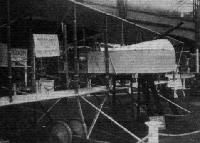 |
Журнал - Flight за 1914 г.
|
| Nacelle and chassis of M. Farman biplane.
|
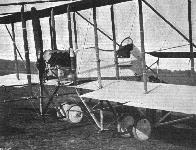 |
Журнал - Flight за 1914 г.
|
| The latest M. Farman biplanes produced by the Aircraft Co. are fitted with nacelles of improved design, which add considerably to the comfort of the occupants and reduce head resistance. With this type of nacelle the machines are capable of a speed of 65 m.p.h.
|
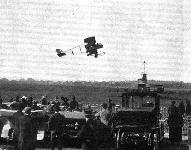 |
Журнал - Flight за 1914 г.
|
| Pierre Verrier on the "Shorthorn" Maurice Farman just starting at Hendon.
|
 |
Журнал - Flight за 1914 г.
|
| M. Verrier flying the Maurice Farman at Hendon.
|
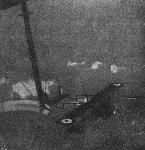 |
Журнал - Flight за 1917 г.
|
| Aerial guardians of Paris, who day and night keep watch against attacks by the air, upon the capital, a monotonous task of strenuous duty, which carries with it little glory by reason of its complete effectiveness as an antidote to the Zeppelin marauders.
|
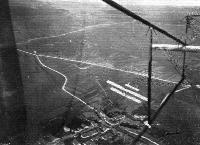 |
Журнал - Flight за 1915 г.
|
| A snap somewhere "over there" from a Caudron biplane at a height of 2,000 feet. The machine in mid-air below is Louis Noel's Maurice Farman.
|
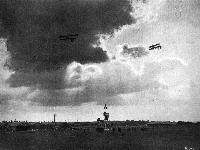 |
Журнал - Flight за 1914 г.
|
| FLYING AT HENDON. - Mr. Grahame-White on an M. Farman and Mr. Lillywine on the twin-rudder G.-W. 'bus over No. 1 pylon.
|
 |
O.Thetford - British Naval Aircraft since 1912 /Putnam/
|
| Maurice Farman Shorthorn (N6310) of the RNAS
|
 |
J.Davilla - Italian Aviation in the First World War. Vol.2: Aircraft A-H /Centennial Perspective/ (74)
|
| Italian Farman M.F.11 in the field.
|
 |
K.Delve - World War One in the Air /Crowood/
|
| The other Farman variant was the Maurice-Farman, shown here in the S.11 Shorthorn version with 2 Squadron RNAS. Maximum speed was only 72mph (116kph) but endurance was almost four hours and the type was, despite its appearance, fairly rugged.
|
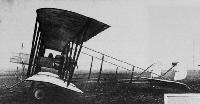 |
Jane's All The World Aircraft 1919 /Jane's/
|
| The M.F.11 "shorthorn" Maurice Farman, with 100 h.p. Renault engine of 1914. Used for bombing, artillery observation, reconnaissance, infantry contact patrols and training.
|
 |
J.Davilla - Italian Aviation in the First World War. Vol.2: Aircraft A-H /Centennial Perspective/ (74)
|
| Farman M.F.11 serial 742 of French MF29.
|
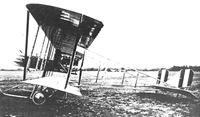 |
J.Davilla - Italian Aviation in the First World War. Vol.2: Aircraft A-H /Centennial Perspective/ (74)
|
| Farman MF.11.
|
 |
В.Шавров - История конструкций самолетов в СССР до 1938 г.
|
| "Морис Фарман" учебный
|
 |
J.Davilla - Italian Aviation in the First World War. Vol.2: Aircraft A-H /Centennial Perspective/ (74)
|
Farman M.F.11 of French MF99.
|
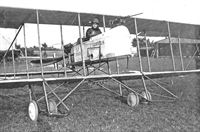 |
J.Davilla - Italian Aviation in the First World War. Vol.2: Aircraft A-H /Centennial Perspective/ (74)
|
| Italian Farman M.F.11 #273 with its pilot.
|
 |
В.Кондратьев - Самолеты первой мировой войны
|
| Итальянский MF.11 с пулеметом "Ревелли"
|
 |
J.Davilla - Italian Aviation in the First World War. Vol.2: Aircraft A-H /Centennial Perspective/ (74)
|
Italian Farman M.F.11 #430 with its crew ready for a mission.
An Italian Maurice Farman type 11, typical of the type that Lang faced on 22 August.
|
 |
K.Delve - World War One in the Air /Crowood/
|
| Egypt was the main location for the various training schools within the Middle East: this Maurice-Farman was with the School of Aerial Gunnery - until written off when a BE2c landed on it!
|
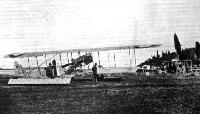 |
Журнал - Flight за 1916 г.
|
| With the re-equipped Serbian Army at Corfu, showing the Serbian Aviation Park and preparing a machine for flight. It is due to the healthy climate of Corfu, the good food and rest in the island, that the Serbian Army has, after its terrible experiences, been brought back into such a splendid condition of health, and has been able to be re-equipped ready to take the field once again.
|
 |
J.Davilla - Italian Aviation in the First World War. Vol.2: Aircraft A-H /Centennial Perspective/ (74)
|
| Farman MF.11.
|
 |
J.Davilla - Italian Aviation in the First World War. Vol.1: Operations /Centennial Perspective/ (73)
|
| Farman MF.11s in service at Cavazzo Carnico.
|
 |
J.Davilla - Italian Aviation in the First World War. Vol.1: Operations /Centennial Perspective/ (73)
|
| Farman MF.11s in service in Macedonia.
|
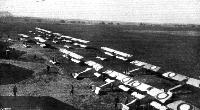 |
Журнал - Flight за 1915 г.
|
| A fleet of avions at an air station "somewhere in France."
|
 |
J.Davilla - Italian Aviation in the First World War. Vol.2: Aircraft A-H /Centennial Perspective/ (74)
|
| One FIAT R.2, two Aviatiks, two Farmans, and one Caproni, at El Palomar, Argentina.
|
 |
Журнал - Flight за 1916 г.
|
| In the Mediterranean with the British Naval Forces. - A grotesque design decorating one of the aeroplanes of the R.N.A.S.
|
 |
Журнал - Flight за 1919 г.
|
| The "Dashing Rumpity," which is bringing in #3 and #5 per five and ten minutes' "flip" in Victoria, Australia, as referred to by "Kahminyah"
|
 |
R.Mikesh, A.Shorzoe - Japanese Aircraft, 1910-1941 /Putnam/
|
| Army Henri Farman Type Model 4 Aeroplane.
|
 |
R.Mikesh, A.Shorzoe - Japanese Aircraft, 1910-1941 /Putnam/
|
| Army Maurice Farman Type Model 6 Aeroplane.
|
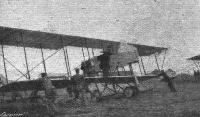 |
Журнал - Flight за 1917 г.
|
| AVIATION IN JAPAN.- At Tokorozawa Military Central Aerodrome. A Japanese 70 h.p. Maurice Farman type of the Japanese Aerial Force.
|
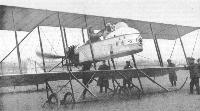 |
R.Mikesh, A.Shorzoe - Japanese Aircraft, 1910-1941 /Putnam/
|
| Kishi No.3 Tsurugi-go Aeroplane.
|
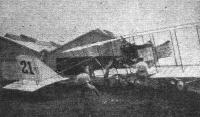 |
Журнал - Flight за 1917 г.
|
| AVIATION IN JAPAN.- A 90 h.p. Maurice Farman on the home ground.
|
 |
R.Mikesh, A.Shorzoe - Japanese Aircraft, 1910-1941 /Putnam/
|
| Sole survivor of the Army Maurice Farman Type Model 6 Aeroplane is No. 266 which is now in the Yasukuni Shrine.
|
 |
E.Hauke, W.Schroeder, B.Totschinger - Die Flugzeuge der k.u.k. Luftfahrtruppe und Seeflieger 1914-1918
|
Farman MF.11, Nr. 2657, italienisches Beuteflugzeug. Das Flugzeug wurde am 17. April 1917 bei St. Veit abgeschossen. Den Luftsieg erzielte Feldpilot Hptm Stojsavljevic mit Beobachter Lt .Josef Friedrich in HB C.I, Flugzeugnummer 68.11. Das Flugzeug erhielt später die Flugzeugnummer 00.40
Farman MF.11, № 2657, итальянский трофейный самолет. Самолет был сбит 17 апреля 1917 года недалеко от Санкт-Фейта. Пилот Hptm Stojsavljevic и наблюдатель лейтенант Josef Friedrich одержали воздушную победу в HB C.I, № 68.11. Позже самолет получил номер 00.40.
|
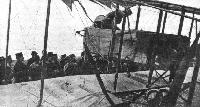 |
Журнал - Flight за 1917 г.
|
| A REMARKABLE ESCAPE. - In these days of high-power high-speed machines it may be well to look back lest one forgets that earlier in the war much excellent work was done on machines which did not begin to compare with the modern aeroplane as regards efficiency and performance. The above photograph, which Is reproduced by courtesy of La Guerre Aerienne, shows the appearance of a biplane on which, in 1915, Captain Morris, since taken prisoner by the Germans, and Corporal de Ram had been for a reconnaissance flight. The machine was heavily shelled, several struts and other wing parts being broken. Corpl. de Ram, in spite of the unsecure foothold offered, climbed out on the lower wing, while at a height of 2,000 metres, and made fast, as well as possible under the conditions, some of the broken parts, which feat enabled the machine to reach home in safety.
|
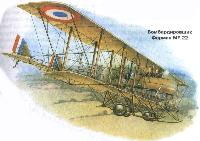 |
А.Шепс - Самолеты Первой мировой войны. Страны Антанты
|
| Бомбардировщик Фарман MF.22
|
 |
Журнал - Flight за 1913 г.
|
|
|
 |
Журнал - Flight за 1914 г.
|
| The 70 h.p, new M. Farman biplane.
|
 |
R.Mikesh, A.Shorzoe - Japanese Aircraft, 1910-1941 /Putnam/
|
| Army Maurice Farman 5 Aeroplanes
|
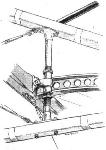 |
Журнал - Flight за 1914 г.
|
| Sketch showing method of adjusting the angle of incidence of the tail plane jon the M. Farman.
|
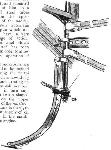 |
Журнал - Flight за 1914 г.
|
| One of the tail skids of the M. Farman.
|
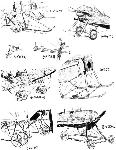 |
Журнал - Flight за 1915 г.
|
| Various types of double skid undercarriages.
|
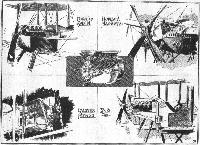 |
Журнал - Flight за 1916 г.
|
| Mounting and housing of Vee-type air-cooled engines. Inset in centre, the Renault engine, showing tubular bearers.
|
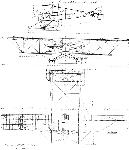 |
Jane's All The World Aircraft 1919 /Jane's/
|
| M. Farman "S-11".
|
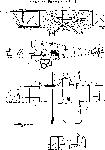 |
В.Кондратьев - Самолеты первой мировой войны
|
| Maurice Farman MF.11
|

